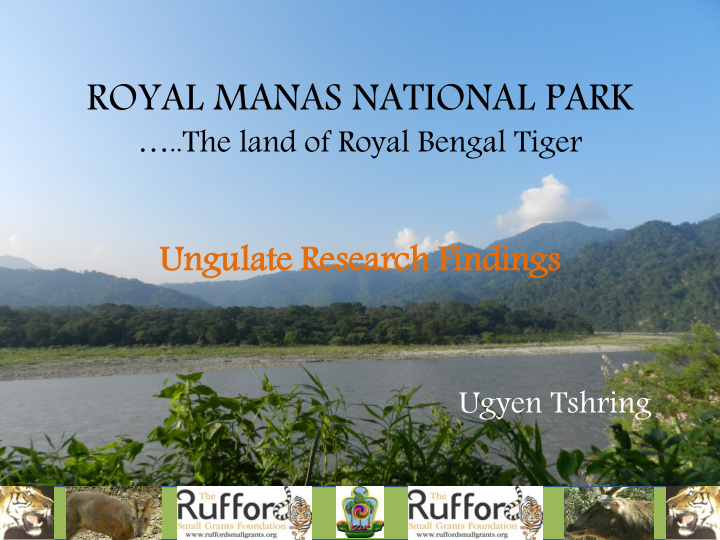



ROYAL MANAS NATIONAL PARK …..The land of Royal Bengal Tiger Ung ngul ulate ate R Researc arch F h Find ndings Ugyen Tshring
Presentation outline • Introduction • Objectives • Methodology • Result and discussion • Conclusion
Introduction Research title: • Distribution and abundance of ungulates along elevation gradients in RMNP Study area: 682km 2 • Survey period January & • February 2014
Introduction • Ungulates are principle prey of tigers • Tiger density in RMNP was 5 tigers/100km 2 • Ungulates species: gaur, sambar, barking deer, wild pig & serow • Lack documentation on distribution & abundance of ungulates • Strategize habitat management of ungulates
Objectives • To estimate abundance of ungulate in relation to habitat types • To map the distribution and predict the suitable habitat of ungulates • To assess affect of salt licks and water holes to ungulate distribution
Methods Study area classified • as <1000, 1000 – 2000, 2000 – 2500, > 2500 masl • Elevation zones corresponds to TFM, STF, WTF, CTF
Methods continued • Five transect randomly laid in all elevation zones • 20 x 20 m quadrat was laid along transect at every 100 m elevation • 2 x 2 m subplot was laid in quadrat to assess ground cover
• Habitat variables Sampling methods • Tree species Enumerated plant species of >1.37 m high • DBH of tree Plant of height >1.37 m was measured • Canopy cover Tree canopy estimated visually • Ground cover Plants <1.37 m were measured as ground cover • Elevation Measured from the center of sample plot • Aspect Recorded degrees from the center of plot • Slope Measured in degrees from the center of plot
Methods continued
Methods continued • Human disturbance: Presence and absence (grazing, forest fire, wood cutting, NWFP collection)
Result & discussion Ungulates abundance Species Total pellet RP UP Abundance RA Gaur 18 13 40 1.38 21.3 Sambar 17 11 42 1.55 23.8 Barking deer 31 23 30 1.35 20.7 Wild pig 11 9 44 1.22 18.8 Serow 3 3 50 1.00 15.4 *RP= Pellet recorded plot, UP= Pellet absent plot, RA= Relative abundance
Result & discussion Ungulate abundance in different elevation range <1000 m 1001-2000 m 2001-2500 m >2500 m Total pellet 45 29 6 0 Gaur 12 5 1 0 Sambar 14 2 1 0 Barking deer 10 18 3 0 Wild pig 7 3 1 0 Serow 2 1 0 0 Mean pellet 9 5.8 1.2 0 Max (Min) 14 (2) 18 (1) 3 (0) 0 (0) SD 4.7 7.0 1.1 0 No. of plots 26 20 5 2
Result & discussion • Occurrence of gaur (r = -.356, p < .05) and sambar (r = -.337, p < .05) is negatively correlated to elevation
Result & discussion Vegetation summary TMF STF WTF CTF H‘ 3.35 3.68 2.54 1.98 Spp. richness ( M ) 8.92 8.28 7.17 6.50 J‘ 0.62 0.73 0.68 0.77 Canopy cover ( M ) 49.88 38.68 40 15 Total stem 69 54 70 58 No. of plots 26 19 6 2
Vegetation structure 3.50 3.00 Log10 (number of individuals) 2.50 1000 - 2000 <1000 2.00 1.50 1.00 0.50 0.00 <20 21-30 31-40 41-50 51-60 61-70 71-80 81-90 >90 <20 21-30 31-40 41-50 51-60 61-70 71-80 81-90 >90 3.00 2.50 Log10 (number of individuals) 2000 - 2500 2.00 > 2500 1.50 1.00 0.50 0.00 <20 21-30 31-40 41-50 51-60 61-70 71-80 81-90 >90 <20 21-30 31-40 41-50 51-60 61-70 71-80 81-90 >90 DBH class of trees above 1.37 m in height
Result & discussion • Summary of of grou ound cov over across el s elev evation ion z zon ones Elevation zones <1000 1000-2000 2000 -2500 > 2500 • No. of species 91 56 19 7 • No. of family 50 30 16 6 • H' 3.2 2.67 1.22 0.47 • Cover (%) grass herb herb herb
Result & discussion Occurrence of pellet group in different slope Gentle Moderate Steep Total Gaur 15 (M=.65) 1 (M=.04) 2 (M=.33) 18 Sambar 15 (M=.65) 2 (M=.08) 0 (M=.00) 17 Barking deer 8 (M=.35) 20 (M=.83) 3 (M=.50 31 Wild pig 6 (M=.65) 5 (M=.21) 0 (M=.00) 11 Serow 2 (M=.09) 1 (M=.04) 0 (M=.00) 3 Total 46 29 5 80 • Elevation zone and slope is positively correlated (r s = .450, p <.01)
Result & discussion Ungulate occurrence across different canopy class Gaur Sambar Barking deer Wild pig Serow Total pellet 70 30 (Mean pellet group in percent) Total pellet group of all species 60 Occurrence of ungulate 25 50 20 40 15 30 10 20 5 10 0 0 E N NE NW S SE SW W Aspect class
Result & discussion Ungulate occurrence across different canopy class Gaur Sambar Barking deer Wild pig Serow Average pellet per plot 14 1.4 Average pellet group per plot 12 1.2 Total pellet count of all species 10 1.0 8 0.8 6 0.6 4 0.4 2 0.2 0 0.0 10 25 40 60 80 95 Percent canopy class
Result & discussion Factor Affecting ungulates distribution
Result & discussion Habitat suitability
Conclusion & Recommendation • High sambar abundance indicates good sign for tiger conservation • Ungulates prefer lower elevation zone also means more carnivore at this zone. However, studies round the season would confirm all season distribution • Habitat conservation at lower elevation would conserve ungulates and their prey • Dietary analysis of ungulates could be a future research area
Acknowledgement • Rufford Small Grant Foundation for financial support • Park management for administrative & logistics support
Recommend
More recommend